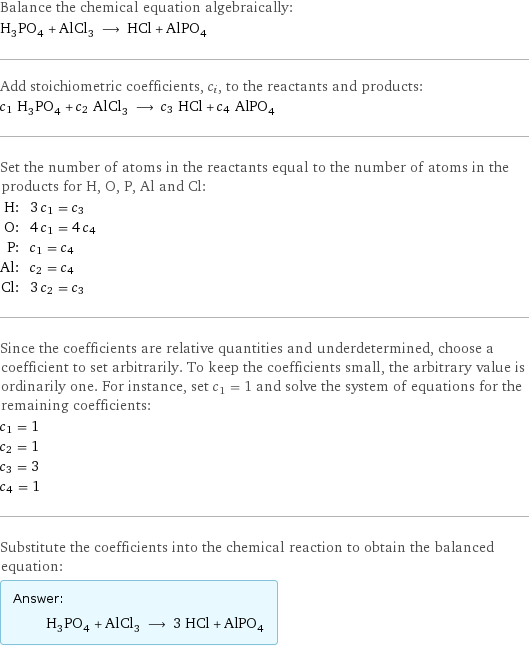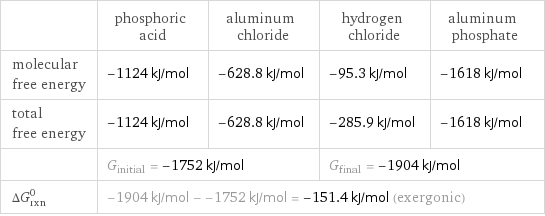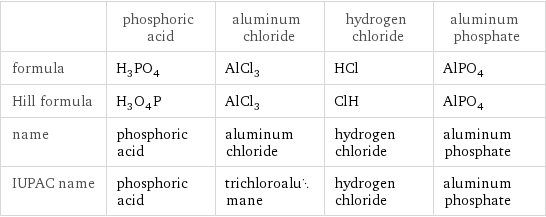Input interpretation

H_3PO_4 phosphoric acid + AlCl_3 aluminum chloride ⟶ HCl hydrogen chloride + AlPO_4 aluminum phosphate
Balanced equation

Balance the chemical equation algebraically: H_3PO_4 + AlCl_3 ⟶ HCl + AlPO_4 Add stoichiometric coefficients, c_i, to the reactants and products: c_1 H_3PO_4 + c_2 AlCl_3 ⟶ c_3 HCl + c_4 AlPO_4 Set the number of atoms in the reactants equal to the number of atoms in the products for H, O, P, Al and Cl: H: | 3 c_1 = c_3 O: | 4 c_1 = 4 c_4 P: | c_1 = c_4 Al: | c_2 = c_4 Cl: | 3 c_2 = c_3 Since the coefficients are relative quantities and underdetermined, choose a coefficient to set arbitrarily. To keep the coefficients small, the arbitrary value is ordinarily one. For instance, set c_1 = 1 and solve the system of equations for the remaining coefficients: c_1 = 1 c_2 = 1 c_3 = 3 c_4 = 1 Substitute the coefficients into the chemical reaction to obtain the balanced equation: Answer: | | H_3PO_4 + AlCl_3 ⟶ 3 HCl + AlPO_4
Structures

+ ⟶ +
Names

phosphoric acid + aluminum chloride ⟶ hydrogen chloride + aluminum phosphate
Reaction thermodynamics
Gibbs free energy

| phosphoric acid | aluminum chloride | hydrogen chloride | aluminum phosphate molecular free energy | -1124 kJ/mol | -628.8 kJ/mol | -95.3 kJ/mol | -1618 kJ/mol total free energy | -1124 kJ/mol | -628.8 kJ/mol | -285.9 kJ/mol | -1618 kJ/mol | G_initial = -1752 kJ/mol | | G_final = -1904 kJ/mol | ΔG_rxn^0 | -1904 kJ/mol - -1752 kJ/mol = -151.4 kJ/mol (exergonic) | | |
Equilibrium constant
![Construct the equilibrium constant, K, expression for: H_3PO_4 + AlCl_3 ⟶ HCl + AlPO_4 Plan: • Balance the chemical equation. • Determine the stoichiometric numbers. • Assemble the activity expression for each chemical species. • Use the activity expressions to build the equilibrium constant expression. Write the balanced chemical equation: H_3PO_4 + AlCl_3 ⟶ 3 HCl + AlPO_4 Assign stoichiometric numbers, ν_i, using the stoichiometric coefficients, c_i, from the balanced chemical equation in the following manner: ν_i = -c_i for reactants and ν_i = c_i for products: chemical species | c_i | ν_i H_3PO_4 | 1 | -1 AlCl_3 | 1 | -1 HCl | 3 | 3 AlPO_4 | 1 | 1 Assemble the activity expressions accounting for the state of matter and ν_i: chemical species | c_i | ν_i | activity expression H_3PO_4 | 1 | -1 | ([H3PO4])^(-1) AlCl_3 | 1 | -1 | ([AlCl3])^(-1) HCl | 3 | 3 | ([HCl])^3 AlPO_4 | 1 | 1 | [AlO4P] The equilibrium constant symbol in the concentration basis is: K_c Mulitply the activity expressions to arrive at the K_c expression: Answer: | | K_c = ([H3PO4])^(-1) ([AlCl3])^(-1) ([HCl])^3 [AlO4P] = (([HCl])^3 [AlO4P])/([H3PO4] [AlCl3])](../image_source/99be797fd203050ed210f7cede2e9583.png)
Construct the equilibrium constant, K, expression for: H_3PO_4 + AlCl_3 ⟶ HCl + AlPO_4 Plan: • Balance the chemical equation. • Determine the stoichiometric numbers. • Assemble the activity expression for each chemical species. • Use the activity expressions to build the equilibrium constant expression. Write the balanced chemical equation: H_3PO_4 + AlCl_3 ⟶ 3 HCl + AlPO_4 Assign stoichiometric numbers, ν_i, using the stoichiometric coefficients, c_i, from the balanced chemical equation in the following manner: ν_i = -c_i for reactants and ν_i = c_i for products: chemical species | c_i | ν_i H_3PO_4 | 1 | -1 AlCl_3 | 1 | -1 HCl | 3 | 3 AlPO_4 | 1 | 1 Assemble the activity expressions accounting for the state of matter and ν_i: chemical species | c_i | ν_i | activity expression H_3PO_4 | 1 | -1 | ([H3PO4])^(-1) AlCl_3 | 1 | -1 | ([AlCl3])^(-1) HCl | 3 | 3 | ([HCl])^3 AlPO_4 | 1 | 1 | [AlO4P] The equilibrium constant symbol in the concentration basis is: K_c Mulitply the activity expressions to arrive at the K_c expression: Answer: | | K_c = ([H3PO4])^(-1) ([AlCl3])^(-1) ([HCl])^3 [AlO4P] = (([HCl])^3 [AlO4P])/([H3PO4] [AlCl3])
Rate of reaction
![Construct the rate of reaction expression for: H_3PO_4 + AlCl_3 ⟶ HCl + AlPO_4 Plan: • Balance the chemical equation. • Determine the stoichiometric numbers. • Assemble the rate term for each chemical species. • Write the rate of reaction expression. Write the balanced chemical equation: H_3PO_4 + AlCl_3 ⟶ 3 HCl + AlPO_4 Assign stoichiometric numbers, ν_i, using the stoichiometric coefficients, c_i, from the balanced chemical equation in the following manner: ν_i = -c_i for reactants and ν_i = c_i for products: chemical species | c_i | ν_i H_3PO_4 | 1 | -1 AlCl_3 | 1 | -1 HCl | 3 | 3 AlPO_4 | 1 | 1 The rate term for each chemical species, B_i, is 1/ν_i(Δ[B_i])/(Δt) where [B_i] is the amount concentration and t is time: chemical species | c_i | ν_i | rate term H_3PO_4 | 1 | -1 | -(Δ[H3PO4])/(Δt) AlCl_3 | 1 | -1 | -(Δ[AlCl3])/(Δt) HCl | 3 | 3 | 1/3 (Δ[HCl])/(Δt) AlPO_4 | 1 | 1 | (Δ[AlO4P])/(Δt) (for infinitesimal rate of change, replace Δ with d) Set the rate terms equal to each other to arrive at the rate expression: Answer: | | rate = -(Δ[H3PO4])/(Δt) = -(Δ[AlCl3])/(Δt) = 1/3 (Δ[HCl])/(Δt) = (Δ[AlO4P])/(Δt) (assuming constant volume and no accumulation of intermediates or side products)](../image_source/ea64d1ff60781cca5bf3a9955456ac9f.png)
Construct the rate of reaction expression for: H_3PO_4 + AlCl_3 ⟶ HCl + AlPO_4 Plan: • Balance the chemical equation. • Determine the stoichiometric numbers. • Assemble the rate term for each chemical species. • Write the rate of reaction expression. Write the balanced chemical equation: H_3PO_4 + AlCl_3 ⟶ 3 HCl + AlPO_4 Assign stoichiometric numbers, ν_i, using the stoichiometric coefficients, c_i, from the balanced chemical equation in the following manner: ν_i = -c_i for reactants and ν_i = c_i for products: chemical species | c_i | ν_i H_3PO_4 | 1 | -1 AlCl_3 | 1 | -1 HCl | 3 | 3 AlPO_4 | 1 | 1 The rate term for each chemical species, B_i, is 1/ν_i(Δ[B_i])/(Δt) where [B_i] is the amount concentration and t is time: chemical species | c_i | ν_i | rate term H_3PO_4 | 1 | -1 | -(Δ[H3PO4])/(Δt) AlCl_3 | 1 | -1 | -(Δ[AlCl3])/(Δt) HCl | 3 | 3 | 1/3 (Δ[HCl])/(Δt) AlPO_4 | 1 | 1 | (Δ[AlO4P])/(Δt) (for infinitesimal rate of change, replace Δ with d) Set the rate terms equal to each other to arrive at the rate expression: Answer: | | rate = -(Δ[H3PO4])/(Δt) = -(Δ[AlCl3])/(Δt) = 1/3 (Δ[HCl])/(Δt) = (Δ[AlO4P])/(Δt) (assuming constant volume and no accumulation of intermediates or side products)
Chemical names and formulas

| phosphoric acid | aluminum chloride | hydrogen chloride | aluminum phosphate formula | H_3PO_4 | AlCl_3 | HCl | AlPO_4 Hill formula | H_3O_4P | AlCl_3 | ClH | AlPO_4 name | phosphoric acid | aluminum chloride | hydrogen chloride | aluminum phosphate IUPAC name | phosphoric acid | trichloroalumane | hydrogen chloride | aluminum phosphate
Substance properties

| phosphoric acid | aluminum chloride | hydrogen chloride | aluminum phosphate molar mass | 97.994 g/mol | 133.3 g/mol | 36.46 g/mol | 121.95 g/mol phase | liquid (at STP) | solid (at STP) | gas (at STP) | solid (at STP) melting point | 42.4 °C | 190 °C | -114.17 °C | 1800 °C boiling point | 158 °C | | -85 °C | density | 1.685 g/cm^3 | | 0.00149 g/cm^3 (at 25 °C) | 2.56 g/cm^3 solubility in water | very soluble | | miscible | insoluble odor | odorless | | |
Units
